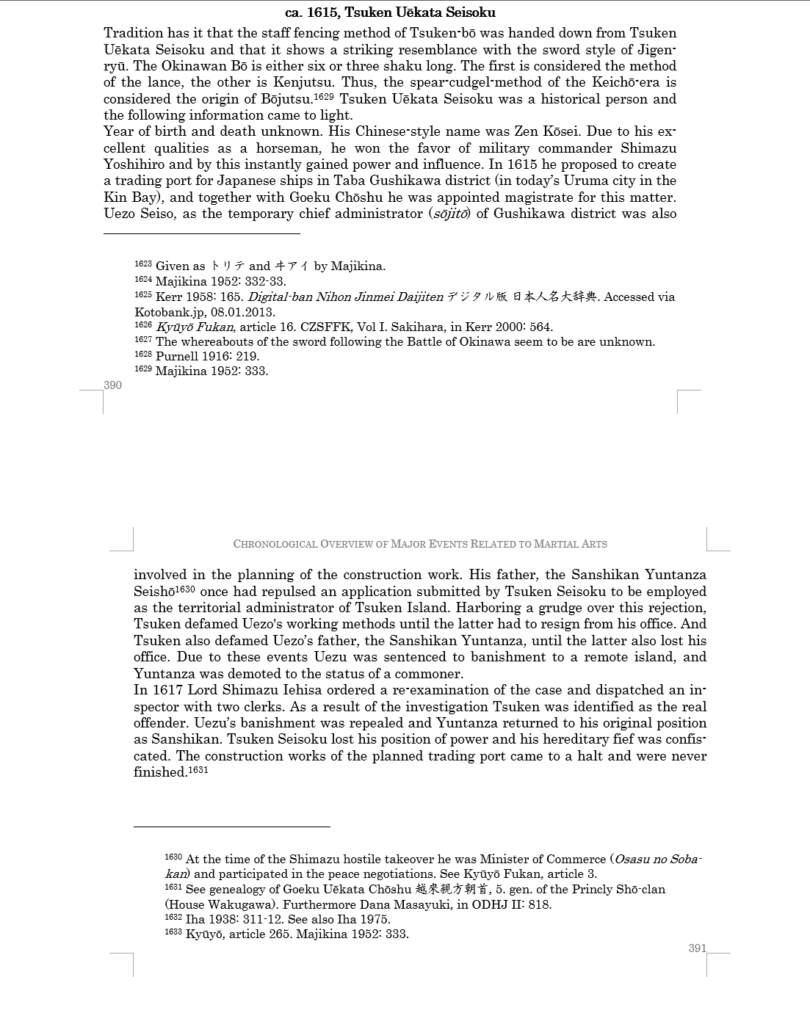As mentioned before, today Tsuken Uēkata Seisoku is considered the originator of Tsuken Bō and an expert in Jigen-ryū swordmanship. Even an English Wikipedia entry says he “was good at riding horses and Jigen-ryū,” presenting the Kyūyō as the source. The Kyūyō is an official history of the Ryūkyū Kingdom compiled between 1743 and 1745.
However, neither Tsuken-bō nor Jigen-ryū are mentioned in the Kyūyō. This said, the Wikipedia entry including its footnote are erroneous and misleading. In all primary sources, Tsuken was only noted for his horsemanship. The earliest source known so far is Majikina Ankō’s Okinawa Issen-nen Shi of 1923. According to it, Tsuken “handed down a staff fencing method called Tsuken-bō, which had a striking resemblance with the sword style of Jigen-ryū.”
Below is the translation of the entry in question from the Kyūyō for your reference.
Kyūyō, Appendix Vol. I-17: In the twenty-seventh year of King Shō Nei’s reign (1615), Tsuken Seisoku slandered the minister Yuntanza Uēkata Seishō, who was degraded to a commoner.”
Tsuken Seisoku was skillful in horseback riding and skillful in the method of taming horses, so much that his name was known even in Satsuma. The new Lord (of Satsuma) invited him and watched it, and said it resembled a rare treasure. For that reason, Tsuken was extremely ambitious and arrogant, insulted and ridiculed the royal subjects, but since he had great power and authority, no one dared to go against him.
One day, Tsuken visited Yuntanza Uēkata Seishō and petitioned to become administrator of the feudal territory of Tsuken Island. Yuntanza objected, and angrily said, “Since ancient times, we have yet to hear of any one person exclusively occupying an entire island. Be silent and don’t repeat it!” Tsuken was so ashamed he wanted to die.
Arriving in the year of the Wood Rabbit (1615), Tsuken requested tools to clear away obstruction and dredge Taba Harbor as a harbor for Japanese ships to stay. His Majesty the King granted the request and ordered Tsuken to act as his magistrate (bugyō), and with good luck, construction started. At that time, Yuntanza’s firstborn son, Uezu Pēkumi Seishō, served as the general estate-steward (sō-jitō) of Gushikawa. In other words, he went to Taba and then went on to fulfil other duties.
It then so happened that Uezu accidentally contracted a poisoning, went home, and stayed in the house, sought medical attention, took medication, and healed himself for ten days, and afterwards returned to Taba Harbor again. Tsuken scolded him, saying, “You sickened yourself and hung around your house, and did not fulfill your duty for the king! You are what is called a ‘person of undeserved reward’!” When Uezu heard this, he became very angry. However, since Tsuken had a lot of power, there was no way that Uezu could argue. He immediately returned home and resigned from his office as estate steward.
Tsuken provoked Yuntanza’s eldest son and accused him of neglecting his royal duties. Slandering him in front of the king, Yuntanza was finally imprisoned. Although the chief jailer was deeply aware of the situation, he feared Tsuken’s power and did not dare to speak out. In the end, Yuntanza was demoted from his office. Claiming that he had spoken ill of the people of Sueyoshi Village, his eldest son Uezu was exiled to Aguni Island. With this, Tsuken took avenge for his grudge of not being given command over Tsuken Island.
In the summer of the year, the three ministers sent a letter to Satsuma, but because he had been demoted, Yuntanza’s signature was missing on that letter. Noting this, to get to know of what crimes were going on, the lord of Satsuma, Shimazu Iehisa (reigned 1602–1638), sent his vassals Hirata, Sawatari, and others to Ryūkyū. After investigating the matter, they did not dare to decide. Instead, they returned to Satsuma, bringing Tsuken and Yuntanza with them. At that time a decision was made, according to which Yuntanza Uēkata Seishō was reinstated in his original office [as minister] again.
As mentioned before, neither Tsuken Bō nor Jigen-ryū have been mentioned in relation to Tsuken Seisoku. It should therefore be considered that the historical reference to Tsuken Uēkata Seisoku is a much later invention of tradition, and that Tsuken Bō in fact is much younger. Actually, it has been considered that it was a certain Tsuken Akan’chū who handed down Tsuken Bō. According to Katsuren Moritoyo, this Tsuken Akan’chū lived at least 200 years after Tsuken Seisoku. A realistic timeframe to look for the origin of Tsuken Bō would therefore be from the 19th century to the early 1900s.
© 2023, Andreas Quast. All rights reserved.

